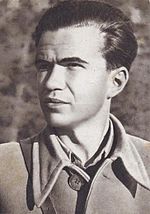Tomb of People's Heroes, Belgrade

Tomb of People's Heroes (Serbian: Гробница народних хероја, romanized: Grobnica narodnih heroja) in Belgrade is located underneath the walls of the Belgrade Fortress. It holds the remains of four recipients of the Order of the People's Hero of SFR Yugoslavia. It was built in 1948. Remains of Ivo Lola Ribar (1916–1943) and Ivan Milutinović (1901–1944) were buried there on 29 March 1948. Remains of Đuro Đaković (1886–1929) were buried on the 20th anniversary of his death on 29 April 1949. Moša Pijade (1890–1957) was buried in the tomb in March 1957. Stevan Bodnarov, a sculptor from Belgrade, designed the busts of Ivo Lola Ribar, Ivan Milutinović and Đuro Đaković in 1949. The bust of Moša Pijade was designed by Slavoljub Stanković in 1959. The tomb was declared Monument of Culture by the City Assembly of Belgrade in 1983.
Excerpt from the Wikipedia article Tomb of People's Heroes, Belgrade (License: CC BY-SA 3.0, Authors, Images).Tomb of People's Heroes, Belgrade
Great Staircase, Belgrade Old Town (Stari Grad Urban Municipality)
Geographical coordinates (GPS) Address External links Nearby Places Show on map
Geographical coordinates (GPS)
| Latitude | Longitude |
|---|---|
| N 44.82194 ° | E 20.44891 ° |
Address
Гробница народних хероја
Great Staircase
11000 Belgrade, Old Town (Stari Grad Urban Municipality)
Central Serbia, Serbia
Open on Google Maps











